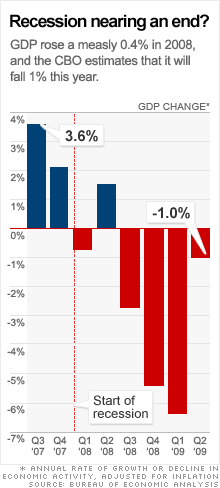Economy shows stabilization: GDP down 1%
A revision to gross domestic product shows the U.S. economy declined at a rate of 1% in the second quarter, matching a previous estimate.

NEW YORK (CNNMoney.com) -- The pace of economic decline in the second quarter slowed at an annual rate of 1%, according to the government's revised reading on gross domestic product. It was unchanged from a previous estimate.
GDP is the broadest measure of the nation's economic activity. Economists surveyed on Briefing.com expected the revised reading to show the economy declined at an annual rate of 1.5% in the second quarter.
The results matched the initial estimate released by the Commerce Department in late July. The decline is still much narrower than the 6.4% drop in the first quarter.
But consumer spending, which accounts for about 70% of GDP, still fell 1%, only slightly better than the 1.2% drop in the first estimate. In the first quarter, consumer spending was actually up 0.6%.
"Consumer spending didn't fall quite as much as the prior estimate, so that means programs like Cash for Clunkers and the [$8,000] tax credit for first-time homebuyers may result in higher demand than previously thought in the coming quarters," said Mark Vitner, economist at Wachovia.
Digging into the numbers. The slower second-quarter contraction was largely due to a smaller decline in exports and business inventories as consumer prices and government spending rocketed higher.
The revised report showed consumer prices rose 0.5% in the quarter, slightly less than the 0.7% increase in the previous estimate. That's still a huge turnaround from the 1.4% drop in prices in the first quarter. Core inflation, excluding volatile food and gas prices, was reported to be at an annual rate of 2%, unchanged from the previous estimate and up from 1.1% in the first quarter.
Business inventories fell by $159.2 billion last quarter, slightly worse than the previous estimate of $141.1 billion and the $113.9 billion drop in the first quarter. But the pace of decline is slowing quickly, suggesting businesses are preparing for economic stabilization -- and perhaps growth -- in the current and coming quarters.
"The fact that the inventory numbers were down more than first reported will make it easier to get a positive GDP number in the third quarter," said Vitner. "The changes are all rather small, but they're all in the right direction. That would tend to strengthen the view that economy is going to snap back in the current quarter."
GDP has contracted for four straight quarters -- the first time that has happened since the Commerce Department began tracking that measure in 1947. But the most recent quarterly decline is the smallest since the second quarter of 2008, giving hope to some economists that the recession is at or nearing an end.
The economy grew just 0.4% last year, and a recent Congressional Budget Office report estimated that it would fall 1% in 2009. ![]()

